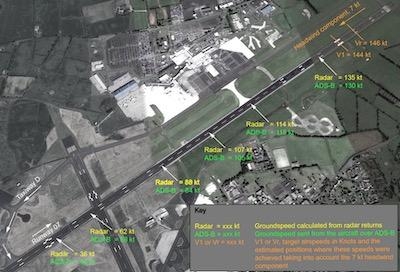Tue, Nov 27, 2018
Temperature Data Incorrectly Entered Into Flight Computer
The U.K. Air Accident Investigation Branch (AAIB) has issued a report from an incident which occurred in July of last year involving a Sunwings Boeing 737-800 departing Belfast for Corfu, Greece.

According to the report, at 1539 hrs on July 21 2017, the Boeing 737-800 took off from Belfast International Airport (BFS) with insufficient power to meet regulated performance requirements. The aircraft struck a supplementary runway approach light, which was 14 inches tall and 95 feet beyond the end of the takeoff runway.
An outside air temperature (OAT) of -52°C (-61°F) had been entered into the Flight Management Computer (FMC) instead of the actual OAT of 16°C (60°F). This, together with the correctly calculated assumed temperature thrust reduction of 48°C (118°F), meant the aircraft engines were delivering only 60% of their maximum rated thrust. The low acceleration of the aircraft was not recognised by the crew until the aircraft was rapidly approaching the end of the runway. The aircraft rotated at the extreme end of the runway and climbed away at a very low rate. The crew did not apply full thrust until the aircraft was approximately 4 km from the end of the runway, at around 800 ft aal.
There was no damage to the aircraft, which continued its flight to Corfu, Greece without further incident. However, it was only the benign nature of the runway clearway and terrain elevation beyond, and the lack of obstacles in the climb-out path which allowed the aircraft to climb away without further collision after it struck the runway light. Had an engine failed at a critical moment during the takeoff, the consequences could have been catastrophic.
The investigation found the following causal factors for this serious incident:
- An incorrect OAT was entered into the FMC, which caused the FMC to calculate an N1 setting for takeoff which was significantly below that required for the aircraft weight and environmental conditions.
- The incorrect OAT was not identified subsequently by the operating crew.
- The abnormal acceleration during the takeoff run was not identified until the aircraft was rapidly approaching the end of the runway, and no action was taken to either reject the takeoff or increase engine thrust.
The investigation found the following contributory factors for this serious incident:
- The aircraft’s FMC did not have the capability to alert the flight crew to the fact that they had entered the incorrect OAT into the FMC, although this capability existed in a later FMC software standard available at the time.
- The Electronic Flight Bags (EFB) did not display N1 on their performance application (some applications do), which meant that the crew could not verify the FMC-calculated N1 against an independently-calculated value.
- The crew were unlikely to detect the abnormally low acceleration because of normal limitations in human performance.
The investigation identified other examples of accidents or serious incidents where there was a gross failure of an aircraft to achieve its expected takeoff performance, and found that technical solutions to address this serious safety issue are now feasible.
(Image from AAIB report)
More News
“Achieving PMA for the S-1200 Series magnetos is another step in expanding our commitment to providing the aviation community with the most trusted and durable ‘firewal>[...]
Also: Bell 505 on SAF, NYPA Gets Flak For BizAv 'Abuse', FAA Venezuela Caution, Horizon Update Textron Aviation has confirmed it will be ending production of the Beechcraft Bonanza>[...]
State-Of-The-Art Common Automation Platform To Replace Legacy Systems The FAA has issued a Request for Information (RFI) regarding the initiative of the Trump Administration and U.>[...]
Kunsan Air Base Reported the Accident During Routine Operations The US Air Force has confirmed that it lost an MQ-9 Reaper drone to the South Korean waters on November 24. The airc>[...]
PowerUp S-1200 Series Approved, Available for 4- And 6-Cylinder Engines Hartzell Engine Tech announced it received FAA Parts Manufacturer Approval for its PowerUp S-1200 Series air>[...]
 Aero-News: Quote of the Day (11.27.25)
Aero-News: Quote of the Day (11.27.25) Airborne 11.26.25: Bonanza-Baron Fini, Archer v LA NIMBYs, Gogo Loses$$$
Airborne 11.26.25: Bonanza-Baron Fini, Archer v LA NIMBYs, Gogo Loses$$$ FAA Seeks Info For New Brand-New ATC Platform
FAA Seeks Info For New Brand-New ATC Platform USAF Reaper Drone Crashes Off the South Korean Coast
USAF Reaper Drone Crashes Off the South Korean Coast Hartzell Engine Tech Magneto Gains FAA-PMA
Hartzell Engine Tech Magneto Gains FAA-PMA



